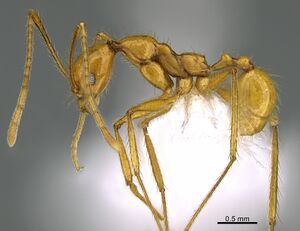Pheidole musinermis
| Pheidole musinermis | |
|---|---|

| |
| Scientific classification | |
| Kingdom: | Animalia |
| Phylum: | Arthropoda |
| Class: | Insecta |
| Order: | Hymenoptera |
| Family: | Formicidae |
| Subfamily: | Myrmicinae |
| Tribe: | Attini |
| Genus: | Pheidole |
| Species: | P. musinermis |
| Binomial name | |
| Pheidole musinermis Longino, 2019 | |
This species occurs in lower montane wet forest. Most collections are from ground baits, to which minors and majors recruit. Minor workers have been collected in a pan trap and a Winkler sample of sifted litter.
Identification
Minor: face smooth and shining; head strongly tapering posteriorly; occipital carina strongly developed; promesonotal groove present, distinctly impressed; lateral pronotum smooth and shiny; katepisternum faintly foveate; propodeal spines nearly absent; gaster smooth and shining; abundant, flexuous, erect setae on mesosomal dorsum, tibiae, and gastral dorsum; color yellow.
Major: inner hypostomal teeth widely spaced, acicular; scape base subterete, narrower than apical portion; face with irregular rugulae anteriorly, entire face with faint foveolate sculpture; promesonotal groove impressed; propodeal spines forming obtuse angles, not dentiform; gastral dorsum foveolate on anterior half; abundant, erect, flexuous setae on face, sides of head, mesosomal dorsum, tibiae, and gastral dorsum.
Measurements, minor worker: HW 0.60, HL 0.87, SL 1.37, EL 0.17, WL 1.23, PSL 0.00, PTW 0.13, PPW 0.21, CI 69, SI 229, PSLI 0, PPI 154 (n=3).
Measurements, major worker: HW 1.59, HL 1.70, SL 1.32, EL 0.25, WL 1.78, PSL 0.02, PTW 0.31, PPW 0.45, CI 94, SI 83, PSLI 2, PPI 147 (n=2).
This species is part of a complex of large, yellow species that occur in Costa Rica. It is similar to Pheidole familiaparra, Pheidole savegre, Pheidole musacolor, and Pheidole tinamu, but is distinguishable by the lack of propodeal spines in the minor worker.
Distribution
Distribution based on Regional Taxon Lists
Neotropical Region: Costa Rica (type locality), Panama.
Distribution based on AntMaps
Distribution based on AntWeb specimens
Check data from AntWeb
Countries Occupied
| Number of countries occupied by this species based on AntWiki Regional Taxon Lists. In general, fewer countries occupied indicates a narrower range, while more countries indicates a more widespread species. |

|
Estimated Abundance
| Relative abundance based on number of AntMaps records per species (this species within the purple bar). Fewer records (to the left) indicates a less abundant/encountered species while more records (to the right) indicates more abundant/encountered species. |

|
Biology
Castes
Worker
Minor
Images from AntWeb
   
| |
| Paratype Minor. Specimen code CASENT0646351. Photographer Michele Esposito. | |
Nomenclature
The following information is derived from Barry Bolton's Online Catalogue of the Ants of the World.
- musinermis. Pheidole musinermis Longino, 2019: 48, fig. 42 (w.) COSTA RICA.
Type Material
- HOLOTYPE: 1 major worker, Costa Rica, San José: Cerro Plano, 9.48117 -83.96363 ±50 m, 1060 m, 6-Jul-2015, ridgetop cloud forest, at bait (ADMAC, Ba-E-06-2-04-07) [MUCR, unique specimen identifier CASENT0631280].
- PARATYPES: major, minor workers: same data as holotype [CAS, DZUP, JTLC, MCZC, MUCR, USNM].
Description
Etymology
The color of a banana, and lacking propodeal spines.
References
References based on Global Ant Biodiversity Informatics
- Longino J. T. 2019. Pheidole (Hymenoptera, Formicidae) of Middle American wet forest. Zootaxa 4599: 1-126

